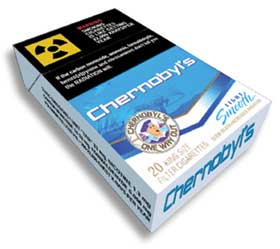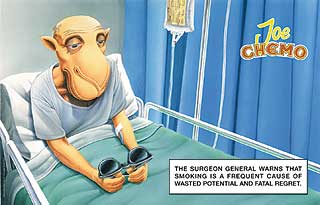Radioactive tobacco
by David Malmo-Levine
02 Jan, 2002
It's not tobacco's tar which kills, but the radiation!
 |
| image: Adbusters |
Cannabis is often compared to tobacco, with the damage caused by smoking tobacco
given as a reason to prohibit use of cannabis. Yet most of the harms caused by
tobacco use are due not to tar, but to the use of radioactive fertilizers.
Surprisingly, radiation seems to be the most dangerous and important factor
behind tobacco lung damage.
Radioactive fertilizer
It's a well established but little known fact that commercially grown tobacco is
contaminated with radiation. The major source of this radiation is phosphate
fertilizer.1 The big tobacco companies all use chemical phosphate fertilizer,
which is high in radioactive metals, year after year on the same soil. These
metals build up in the soil, attach themselves to the resinous tobacco leaf and
ride tobacco trichomes in tobacco smoke, gathering in small "hot spots" in the
small-air passageways of the lungs.2 Tobacco is especially effective at
absorbing radioactive elements from phosphate fertilizers, and also from
naturally occurring radiation in the soil, air, and water.3
To grow what the tobacco industry calls "more flavorful" tobacco, US farmers use
high-phosphate fertilizers. The phosphate is taken from a rock mineral, apatite,
that is ground into powder, dissolved in acid and further processed. Apatite
rock also contains radium, and the radioactive elements lead 210 and polonium
210. The radioactivity of common chemical fertilizer can be verified with a
Geiger-Mueller counter and an open sack of everyday 13-13-13 type of fertilizer
(or any other chemical fertilizer high in phosphate content).4
Conservative estimates put the level of radiation absorbed by a pack-and-a-half
a day smoker at the equivalent of 300 chest X-rays every year.5 The Office of
Radiation, Chemical & Biological Safety at Michigan State University reports
that the radiation level for the same smoker was as high as 800 chest X-rays per
year.6 Another report argues that a typical nicotine user might be getting the
equivalent of almost 22,000 chest X-rays per year.7
US Surgeon General C Everett Koop stated on national television in 1990 that
tobacco radiation is probably responsible for 90% of tobacco-related cancer.8 Dr
RT Ravenholt, former director of World Health Surveys at the Centers for Disease
Control, has stated that "Americans are exposed to far more radiation from
tobacco smoke than from any other source."9
Researchers have induced cancer in animal test subjects that inhaled polonium
210, but were unable to cause cancer through the inhalation of any of the
non-radioactive chemical carcinogens found in tobacco.10 The most potent
non-radioactive chemical, benzopyrene, exists in cigarettes in amounts
sufficient to account for only 1% of the cancer found in smokers.9
Smoke screen
Surprisingly, the US National Cancer Institute, with an annual budget of $500
million, has no active grants for research on radiation as a cause of lung
cancer.1
Tobacco smoking has been popular for centuries,11 but lung cancer rates have
only increased significantly after the 1930's.12 In 1930 the lung cancer death
rate for white US males was 3.8 per 100,000 people. By 1956 the rate had
increased almost tenfold, to 31 per 100,000.13 Between 1938 and 1960, the level
of polonium 210 in American tobacco tripled, commensurate with the increased use
of chemical fertilizers.14
Publicly available internal memos of tobacco giant Philip Morris indicate that
the tobacco corporation was well aware of radiation contamination in 1974, and
that they had means to remove polonium from tobacco in 1980, by using ammonium
phosphate as a fertilizer, instead of calcium phosphate. One memo describes
switching to ammonium phosphate as a "valid but expensive point."15
Attorney Amos Hausner, son of the prosecutor who sent Nazi Adolf Eichmann to the
gallows, is using these memos as evidence to fight the biggest lawsuit in
Israel's history, to make one Israeli and six US tobacco companies pay up to $8
billion for allegedly poisoning Israelis with radioactive cigarettes.16
 |
| image: Adbusters |
Organic solutions
The radioactive elements in phosphate fertilizers also make their way into our
food and drink. Many food products, especially nuts, fruits, and leafy plants
like tobacco absorb radioactive elements from the soil, and concentrate them
within themselves.17
The fluorosilicic acid used to make the "fluoridated water" most of us get from
our taps is made from various fluorine gases captured in pollution scrubbers
during the manufacture of phosphate fertilizers. This fluoride solution put into
our water for "strong teeth" also contains radioactive elements from the
phosphate extraction.18
Although eating and drinking radioactive products is not beneficial, the most
harmful and direct way to consume these elements is through smoking them.19
The unnecessary radiation delivered from soil-damaging, synthetic chemical
fertilizers can easily be reduced through the use of alternative phosphate
sources including organic fertilizers.20 In one test, an organic fertilizer
appeared to emit less alpha radiation than a chemical fertilizer.21 More tests
are needed to confirm this vital bit of harm-reduction information.
Organic fertilizers such as organic vegetable compost, animal manure, wood ash
and seaweed have proven to be sustainable and non-harmful to microbes, worms,
farmers and eaters or smokers. Chemical phosphates may seem like a bargain
compared to natural phosphorous, until you factor in the health and
environmental costs.
To ensure that cannabis remains the safest way to get high, we must always use
organic fertilizers and non-toxic pesticides. We should also properly cure the
buds, take advantage of high-potency breeding and use smart-smoking devices like
vaporizers and double-chambered glass water bongs. These will all help to
address concern over potential lung damage far more effectively than either a
jail cell or a 12-step program.
Tobacco smokers can also use this information to avoid radioactive brands of
tobacco. American Spirit is one of a few companies that offers an organic line
of cigarettes, and organic cigars are also available from a few companies. You
can also grow your own tobacco, which is surprisingly easy and fun.
Until the public has an accurate understanding of how phosphate fertilizers
carry radiation, and why commercial tobacco causes lung cancer but cannabis does
not, there will be many needless tobacco-related deaths, and increased
resistance to the full legalization of marijuana.
References
1. Winters, TH and Franza, JR. 'Radioactivity in Cigarette Smoke,' New England
Journal of Medicine, 1982. 306(6): 364-365,
web
2. Edward A Martell, PhD. 'Letter to the Editor,' New England Journal of
Medicine, 1982. 307(5): 309-313,
web
3. Ponte, Lowell. 'Radioactivity: The New-Found Danger in Cigarettes,' Reader's
Digest, March 1986. pp. 123-127.
4. Kilthau, GF. 'Cancer risk in relation to radioactivity in tobacco,'
Radiologic Technology, Vol 67, January 11, 1996,
web
5. Maryland Department of Health & Mental Hygiene. Website, 2001,
web
6. Office of Environmental Health and Safety, Utah State University. 'Cigarettes
are a Major Source of Radiation Exposure,' Safety Line, Issue 33, Fall 1996,
web
7. Nursing & Allied Healthweek, 1996,
8. Herer, Jack. The Emperor Wears No Clothes, 11th edition, 1998. p. 110,
web
9. Litwak, Mark. 'Would You Still Rather Fight Than Switch?' Whole Life Times,
April/May, 1985. pp 11,
web
10. Yuille, CL; Berke, HL; Hull, T. 'Lung cancer following Pb210 inhalation in
rats.' Radiation Res, 1967. 31:760-774.
11. Borio, Gene. Tobacco Timeline. Website, 2001,
web
12. Taylor, Peter. The Smoke Ring. Pantheon Books, NY, 1984. pp. 2-3,
web
13. Smith, Lendon, MD. 'There Ought to Be a Law,'
Chiroweb.com, November 20, 1992,
web
14. Marmorstein, J. 'Lung cancer: is the increasing incidence due to radioactive
polonium in cigarettes?' South Medical Journal, February 1986. 79(2):145-50,
web
15. Phillip Morris internal memo, April 2 1980. Available online at
www.pmdocs.com,
web
16. Goldin, Megan. "'Radioactive' cigarettes cited in Israeli lawsuit." Reuters,
June 23, 2000.
17. Health Physics Society, 'Naturally occuring radioactive materials factsheet,'
1997. see also: Watters, RL. Hansen, WR. 'The hazards implication of the
transfer of unsupported 210 Po from alkaline soil to plants,' Health Physics
Journal, April 1970. 18(4):409-13,
web and
web
18. Glasser, George. 'Fluoride and the phosphate connection.' Earth Island
Journal, earthisland.org,
web
19. Watson, AP. 'Polonium-210 and Lead-210 in Food and Tobacco Products: A
Review of Parameters and an Estimate of Potential Exposure and Dose.' Oak Ridge
National Laboratory, 1983. Florida Institute of Phosphate Research.
20. Burnett, William; Schultz, Michael; Hull, Carter. 'Behavior of Radionuclides
During Ammonocarbonation of Phosphogypsum.' Florida State University, Florida
Institute of Phosphate Research. March, 1995,
web
21. Hornby, Paul, Dr. Personal communication, 2001.
• David Malmo-Levine: email
dagreenmachine@excite.com
• American Spirit: 1-800-332-5595; web
www.nascigs.com


